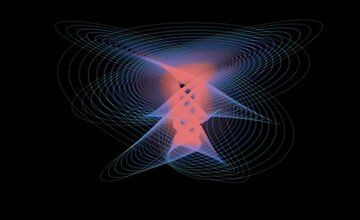-
Урок 1.
00:08:01
Broad introduction to neural time series analysis
-
Урок 2.
00:15:58
Neural data science as source sepatation
-
Урок 3.
00:11:59
What to expect from this course
-
Урок 4.
00:02:31
A quick note about how this went from 2 to 1 course
-
Урок 5.
00:21:37
Origin, significance, and interpretation of EEG
-
Урок 6.
00:13:40
Overview of possible preprocessing steps
-
Урок 7.
00:19:02
ICA for data cleaning
-
Урок 8.
00:15:49
Signal artifacts (not) to worry about
-
Урок 9.
00:12:28
Topographical mapping
-
Урок 10.
00:16:20
Overview of time-domain analyses (ERPs)
-
Урок 11.
00:16:40
Motivations for rhythm-based analyses
-
Урок 12.
00:16:12
Interpreting time-frequency plots
-
Урок 13.
00:04:27
The empirical datasets used in this course
-
Урок 14.
00:19:32
MATLAB: EEG dataset
-
Урок 15.
00:08:15
MATLAB: V1 dataset
-
Урок 16.
00:04:11
Where to get more EEG data?
-
Урок 17.
00:21:58
Simulating data to understand analysis methods
-
Урок 18.
00:04:09
Problem set: introduction and explanation
-
Урок 19.
00:35:19
Problem set (1/2): Simulating and visualizing data
-
Урок 20.
00:36:19
Problem set (2/2): Simulating and visualizing data
-
Урок 21.
00:08:27
Why simulate data?
-
Урок 22.
00:12:25
Generating white and pink noise
-
Урок 23.
00:23:02
The three important equations (sine, Gaussian, Euler's)
-
Урок 24.
00:06:42
Generating "chirps" (frequency-modulated signals)
-
Урок 25.
00:05:28
Non-stationary narrowband activity via filtered noise
-
Урок 26.
00:07:23
Transient oscillation
-
Урок 27.
00:12:59
The eeglab EEG structure
-
Урок 28.
00:09:31
Project 1-1: Channel-level EEG data
-
Урок 29.
00:11:48
Project 1-1: Solutions
-
Урок 30.
00:09:06
Projecting dipoles onto EEG electrodes
-
Урок 31.
00:04:51
Project 1-2: dipole-level EEG data
-
Урок 32.
00:10:47
Project 1-2: Solutions
-
Урок 33.
00:17:43
Event-related potential (ERP)
-
Урок 34.
00:16:56
Lowpass filter an ERP
-
Урок 35.
00:07:10
Compute the average reference
-
Урок 36.
00:06:12
Butterfly plot and topo-variance time series
-
Урок 37.
00:12:58
Topography time series
-
Урок 38.
00:09:38
Simulate ERPs from two dipoles
-
Урок 39.
00:07:08
Project 2-1: Quantify the ERP as peak-mean or peak-to-peak
-
Урок 40.
00:15:20
Project 2-1: Solutions
-
Урок 41.
00:02:31
Project 2-2: ERP peak latency topoplot
-
Урок 42.
00:08:09
Project 2-2: Solutions
-
Урок 43.
00:09:43
Time and frequency domains
-
Урок 44.
00:08:06
Sine waves
-
Урок 45.
00:09:26
MATLAB: Sine waves and their parameters
-
Урок 46.
00:14:24
Complex numbers
-
Урок 47.
00:12:04
Euler's formula
-
Урок 48.
00:12:25
MATLAB: Complex numbers and Euler's formula
-
Урок 49.
00:09:41
The dot product
-
Урок 50.
00:10:38
MATLAB: Dot product and sine waves
-
Урок 51.
00:04:52
Complex sine waves
-
Урок 52.
00:06:33
MATLAB: Complex sine waves
-
Урок 53.
00:07:13
The complex dot product
-
Урок 54.
00:13:55
MATLAB: The complex dot product
-
Урок 55.
00:12:31
Fourier coefficients
-
Урок 56.
00:15:23
MATLAB: The discrete-time Fourier transform
-
Урок 57.
00:16:53
MATLAB: Fourier coefficients as complex numbers
-
Урок 58.
00:12:23
Frequencies in the Fourier transform
-
Урок 59.
00:14:34
Positive and negative frequencies
-
Урок 60.
00:08:34
Accurate scaling of Fourier coefficients
-
Урок 61.
00:17:28
MATLAB: Positive/negative spectrum; amplitude scaling
-
Урок 62.
00:14:51
MATLAB: Spectral analysis of resting-state EEG
-
Урок 63.
00:18:52
MATLAB: Quantify alpha power over the scalp
-
Урок 64.
00:09:46
The perfection of the Fourier transform
-
Урок 65.
00:06:52
The inverse Fourier transform
-
Урок 66.
00:10:06
MATLAB: Reconstruct a signal via inverse FFT
-
Урок 67.
00:10:15
Frequency resolution and zero-padding
-
Урок 68.
00:16:39
MATLAB: Frequency resolution and zero-padding
-
Урок 69.
00:08:06
Estimation errors and Fourier coefficients
-
Урок 70.
00:13:07
Signal nonstationarities
-
Урок 71.
00:10:32
MATLAB: Examples of sharp nonstationarities on power spectra
-
Урок 72.
00:17:11
MATLAB: Examples of smooth nonstationarities on power spectra
-
Урок 73.
00:11:14
Welch's method for smooth spectral decomposition
-
Урок 74.
00:11:48
MATLAB: Welch's method on phase-slip data
-
Урок 75.
00:06:28
MATLAB: Welch's method on resting-state EEG data
-
Урок 76.
00:05:37
MATLAB: Welch's method on V1 dataset
-
Урок 77.
00:33:01
Problem set (1/2): Spectral analyses of real and simulated data
-
Урок 78.
00:37:10
Problem set (2/2): Spectral analyses of real and simulated data
-
Урок 79.
00:04:19
Program the Fourier transform from scratch!
-
Урок 80.
00:05:52
Program the inverse Fourier transform from scratch!
-
Урок 81.
00:06:01
Spectral separation on simulated dipole data
-
Урок 82.
00:12:38
FFT of stationary and non-stationary simulated data
-
Урок 83.
00:12:01
FFT and Welch's method on EEG resting state data
-
Урок 84.
00:16:51
To taper or not to taper?
-
Урок 85.
00:04:54
Extracting average power from a frequency band
-
Урок 86.
00:11:40
Comparing average spectra vs. spectra of an average
-
Урок 87.
00:04:23
Project 3-1: Topography of spectrally separated activity
-
Урок 88.
00:11:56
Project 3-1: Solutions
-
Урок 89.
00:03:52
Project 3-2: Topography of alpha-theta ratio
-
Урок 90.
00:11:22
Project 3-2: Solutions
-
Урок 91.
00:17:48
Morlet wavelets in time and in frequency
-
Урок 92.
00:14:10
MATLAB: Getting to know Morlet wavelets
-
Урок 93.
00:23:37
Convolution in the time domain
-
Урок 94.
00:14:21
MATLAB: Time-domain convolution
-
Урок 95.
00:19:30
Convolution as spectral multiplication
-
Урок 96.
00:08:29
MATLAB: The five steps of convolution
-
Урок 97.
00:12:57
MATLAB: Convolve real data with a Gaussian
-
Урок 98.
00:08:33
MATLAB: Complex Morlet wavelets
-
Урок 99.
00:12:44
Complex Morlet wavelet convolution
-
Урок 100.
00:07:55
Convolution coding tips
-
Урок 101.
00:19:03
MATLAB: Complex Morlet wavelet convolution
-
Урок 102.
00:08:27
MATLAB: Convolution with all trials!
-
Урок 103.
00:09:51
MATLAB: A full time-frequency power plot!
-
Урок 104.
00:13:07
Averaging phase values
-
Урок 105.
00:15:17
Inter-trial phase clustering (ITPC/ITC)
-
Урок 106.
00:13:19
MATLAB: ITPC
-
Урок 107.
00:18:19
Parameters of Morlet wavelet (time-frequency trade-off)
-
Урок 108.
00:18:56
MATLAB: Time-frequency trade-off
-
Урок 109.
00:05:30
The stationarity assumption of wavelet convolution
-
Урок 110.
00:14:57
The "1/f" structure of spectral brain dynamics
-
Урок 111.
00:18:35
Baseline normalization of time-frequency power
-
Урок 112.
00:13:43
MATLAB: Baseline normalization of TF plots
-
Урок 113.
00:11:29
Scale-free dynamics via detrended fluctuation analysis (DFA)
-
Урок 114.
00:21:19
MATLAB: detrended fluctuation analysis
-
Урок 115.
00:23:07
The filter-Hilbert time-frequency method
-
Урок 116.
00:17:28
MATLAB: Filter-Hilbert
-
Урок 117.
00:07:34
The short-time Fourier transform (STFFT)
-
Урок 118.
00:07:41
MATLAB: STFFT
-
Урок 119.
00:13:23
Comparing wavelet, filter-Hilbert, and STFFT
-
Урок 120.
00:11:04
The multi-taper method
-
Урок 121.
00:16:17
Within-subject, cross-trial regression
-
Урок 122.
00:23:42
MATLAB: Cross-trial regression
-
Урок 123.
00:09:25
Temporal resolution vs. precision, pre- and post-convolution
-
Урок 124.
00:17:07
MATLAB: Downsampling time-frequency results
-
Урок 125.
00:13:46
MATLAB: Linear vs. logarithmic frequency scaling
-
Урок 126.
00:12:24
Separating phase-locked and non-phase-locked activity
-
Урок 127.
00:19:28
MATLAB: Total, non-phase-locked, and phase-locked power
-
Урок 128.
00:09:42
Edge effects, buffer zones, and data epoch length
-
Урок 129.
00:29:19
Problem set (1/3): Time-frequency analysis
-
Урок 130.
00:21:19
Problem set (2/3): Time-frequency analysis
-
Урок 131.
00:35:00
Problem set (2/3): Time-frequency analysis
-
Урок 132.
00:09:58
Create a family of complex Morlet wavelets
-
Урок 133.
00:12:40
Create a time-frequency plot of a nonlinear chirp
-
Урок 134.
00:09:58
Compare wavelet-derived spectrum and FFT
-
Урок 135.
00:11:25
Wavelet convolution of close frequencies
-
Урок 136.
00:07:52
Time-frequency power of multitrial EEG activity
-
Урок 137.
00:11:06
Baseline normalize power with dB and % change
-
Урок 138.
00:11:02
Exploring wavelet parameters in real data
-
Урок 139.
00:10:39
Exploring wavelet parameters in simulated data
-
Урок 140.
00:09:45
Inter-trial phase clustering before vs. after removing ERP
-
Урок 141.
00:07:38
Downsampling time-frequency power
-
Урок 142.
00:06:56
Visualize time-frequency power from all channels
-
Урок 143.
00:12:42
Instantaneous frequency in simulated data
-
Урок 144.
00:08:19
Instantaneous frequency in real data
-
Урок 145.
00:04:38
Project 4-1: Phase-locked, non-phase-locked, and total power
-
Урок 146.
00:13:53
Project 4-1: Solutions
-
Урок 147.
00:12:21
Narrowband filtering and the Hilbert transform
-
Урок 148.
00:03:02
Project 4-2: Time-frequency power plot via filter-Hilbert
-
Урок 149.
00:07:38
Project 4-2: Solutions
-
Урок 150.
00:16:12
Four things to keep in mind about connectivity
-
Урок 151.
00:10:30
Volume conduction and what to do about it
-
Урок 152.
00:13:13
Intuition about phase synchronization
-
Урок 153.
00:09:42
Inter-site phase clustering (ISPC)
-
Урок 154.
00:17:32
MATLAB: ISPC
-
Урок 155.
00:11:03
Surface Laplacian for connectivity analyses
-
Урок 156.
00:10:20
MATLAB: Laplacian in simulated data
-
Урок 157.
00:14:45
MATLAB: Laplacian in real EEG data
-
Урок 158.
00:12:14
Phase-lag-based connectivity
-
Урок 159.
00:14:40
MATLAB: phase-lag index
-
Урок 160.
00:17:49
When to use phase-lag vs. phase-clustering measures
-
Урок 161.
00:18:59
MATLAB: Phase synchronization in voltage and Laplacian data
-
Урок 162.
00:07:17
Connectivity over time vs. over trials
-
Урок 163.
00:07:43
MATLAB: Connectivity over time vs. over trials
-
Урок 164.
00:17:38
MATLAB: Simulating data to test connectivity methods
-
Урок 165.
00:10:20
Two methods of power-based connectivity
-
Урок 166.
00:32:18
Granger causality (prediction)
-
Урок 167.
00:22:37
MATLAB: Granger causality
-
Урок 168.
00:12:58
"Hubness" from graph theory
-
Урок 169.
00:23:00
MATLAB: Connectivity hubs
-
Урок 170.
00:06:20
When to use which connectivity method?
-
Урок 171.
00:22:30
Problem set (1/2): Pairwise synchronization
-
Урок 172.
00:32:08
Problem set (2/2): Pairwise synchronization
-
Урок 173.
00:12:18
Synchronization in simulated noisy oscillators
-
Урок 174.
00:12:05
Spurious connectivity in narrowband noise
-
Урок 175.
00:15:41
Phase synchronization matrices in multitrial data
-
Урок 176.
00:17:11
Power time series correlations
-
Урок 177.
00:11:14
Power correlations over trials
-
Урок 178.
00:10:43
Scalp Laplacian for electrode-level connectivity
-
Урок 179.
00:14:04
All-to-all synchronization and "hubness" (graph theory)
-
Урок 180.
00:14:46
Phase-lag index
-
Урок 181.
00:05:09
Project 5-1: ISPC and PLI, with and without Laplacian
-
Урок 182.
00:05:32
Project 5-1: Solutions
-
Урок 183.
00:03:51
Project 5-2: Seeded phase vs. power coupling
-
Урок 184.
00:07:37
Project 5-2: Solutions
-
Урок 185.
00:15:30
Introduction: The basis of statistics, necessity, and levels
-
Урок 186.
00:14:34
Parametric vs. nonparametric statistics
-
Урок 187.
00:25:59
Permutation-based statistics
-
Урок 188.
00:20:03
MATLAB: Permutation testing and shuffling
-
Урок 189.
00:23:58
MATLAB: Permutation testing in real data
-
Урок 190.
00:08:35
Multiple comparisons and limitations of Bonferroni method
-
Урок 191.
00:10:52
Cluster-based multiple comparisons correction
-
Урок 192.
00:12:42
MATLAB: Cluster correction
-
Урок 193.
00:09:49
Extreme pixel-based multiple comparisons correction
-
Урок 194.
00:14:04
MATLAB: Extreme pixel correction
-
Урок 195.
00:05:32
Illustrating statistical significance in plots
-
Урок 196.
00:10:43
Subject- vs. group-level analyses
-
Урок 197.
00:06:07
Error bars and guessing significance
-
Урок 198.
00:18:37
Three approaches for group-level statistics
-
Урок 199.
00:15:00
MATLAB: Extracting features for group analyses
-
Урок 200.
00:14:00
Circular inference ("double-dipping")
-
Урок 201.
00:19:52
Permutation testing for one variable and two groups
-
Урок 202.
00:08:22
Meta-permutation test for increased stability
-
Урок 203.
00:18:35
Permutation testing in simulated time series
-
Урок 204.
00:13:56
Permutation testing for cluster correction in simulated data
-
Урок 205.
00:13:20
Permutation testing and cluster correction in real EEG data
-
Урок 206.
00:05:06
Project 7-1: Effects of noise smoothness on cluster correction
-
Урок 207.
00:15:31
Project 7-1: Solutions
-
Урок 208.
00:08:11
Project 7-2: Simulate time-frequency data for statistical testing
-
Урок 209.
00:14:02
Project 7-2: Solutions
-
Урок 210.
00:01:18
Background knowledge for this section
-
Урок 211.
00:10:10
Simulate multicomponent EEG data
-
Урок 212.
00:15:59
Create covariance matrices based on time and on frequency
-
Урок 213.
00:11:16
Principal components analysis (PCA) of simulated data
-
Урок 214.
00:10:58
Time-based GED for source-separation in simulated data
-
Урок 215.
00:09:27
Frequency-based GED for source-separation in simulated data
-
Урок 216.
00:10:48
Project 6-1: GED for interacting alpha sources
-
Урок 217.
00:08:53
Project 6-1: Solutions



